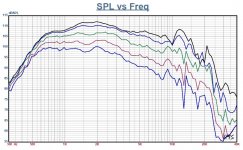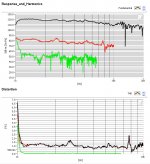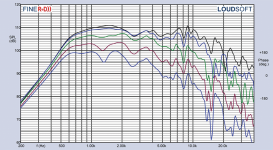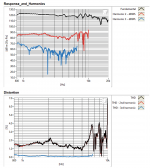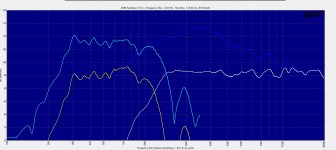The SA102 uses a 4" diaphragm 1.4" exit B&C DE1090TN.
I had thought the SA102 video depicted the SA102, but as Todd Michael pointed out, the video images I posted were actually of the 3-way SA153, which uses a co-ax mid-high driver.
As the SA153 is tri-amped (400Hz, 7kHz crossover frequencies), I would assume time/phase compensation is used in it's processing to align all three components.
Art
Nice catch!
For comparison's sake, here's the measured polars of the B&C DE1090TN vs the Eminence N314X and their distortion measurements. These were done by Vance Dickason. Note that the horns are different.
Attachments
Hey Guys,
- Art is correct that all time-phase correction is taken care of with the internal DSP on all our self-powered cabinets.
- Yes the U15 was designed by myself long ago without any input from Tom or anyone else. This is true for all the products that Yorkville produces using the licensed technologies. Perhaps but a couple of the tapped horn sub woofers which Tom aided in the cabinet layout and simulations. He really is a wizard at stuffing 50 pounds of stuff into a 25 pound bag 🙂
- Yes I did turn Tom onto BMS drivers long ago. We were both searching for HF drivers that could handle being crossed over as low as possible due to the fact that getting mids to go as high as possible is always a challenge in a Synergy horn. The large format BMS co-ax units were a key component a couple years ago when I completely redesigned all of IMAX`s loudspeakers which we OEM for them. Combining these co-axs with the para-line lens and Synergy technologies allowed me to meet some very tough performance specs. The new cabinets completely outperform what they had been using for many years. Being a large company that buys millions of dollars worth of raw frame drivers a year I am constantly being sent the "latest and greatest" from all the big manufacturers and I always pass on anything interesting I see to Tom.
- I did develop the Celstion mids for use in the U15 and I know Tom implemented them in some of his designs. Which ones I'm not sure but for the money they are very hard to beat.
-For anyone wanting to take a shot at a DIY Synergy horn the components from the U15 are very hard to beat at a reasonable price. I think we even have a very small amount of horns left in stock (YS part# H32) that one might be able to purchase. When used with the Celestion mids and any good quality compression driver they will yield excellent results with a 60 degree conical pattern. I would avoid designing a passive crossover as they are extremely difficult. Besides there are so many affordable DIY DSP processing and amplifier options out there that with a minimum of effort even a DIY`r can produce really fantastic results without spending a ton of money. Attached is both the RAW SPL responses as well as through the passive crossover of the U15 horn with the Celestion mids and BMS 4550. It`s about as good a starting point as you`re gonna get. 🙂
Cheers,
T.
- Art is correct that all time-phase correction is taken care of with the internal DSP on all our self-powered cabinets.
- Yes the U15 was designed by myself long ago without any input from Tom or anyone else. This is true for all the products that Yorkville produces using the licensed technologies. Perhaps but a couple of the tapped horn sub woofers which Tom aided in the cabinet layout and simulations. He really is a wizard at stuffing 50 pounds of stuff into a 25 pound bag 🙂
- Yes I did turn Tom onto BMS drivers long ago. We were both searching for HF drivers that could handle being crossed over as low as possible due to the fact that getting mids to go as high as possible is always a challenge in a Synergy horn. The large format BMS co-ax units were a key component a couple years ago when I completely redesigned all of IMAX`s loudspeakers which we OEM for them. Combining these co-axs with the para-line lens and Synergy technologies allowed me to meet some very tough performance specs. The new cabinets completely outperform what they had been using for many years. Being a large company that buys millions of dollars worth of raw frame drivers a year I am constantly being sent the "latest and greatest" from all the big manufacturers and I always pass on anything interesting I see to Tom.
- I did develop the Celstion mids for use in the U15 and I know Tom implemented them in some of his designs. Which ones I'm not sure but for the money they are very hard to beat.
-For anyone wanting to take a shot at a DIY Synergy horn the components from the U15 are very hard to beat at a reasonable price. I think we even have a very small amount of horns left in stock (YS part# H32) that one might be able to purchase. When used with the Celestion mids and any good quality compression driver they will yield excellent results with a 60 degree conical pattern. I would avoid designing a passive crossover as they are extremely difficult. Besides there are so many affordable DIY DSP processing and amplifier options out there that with a minimum of effort even a DIY`r can produce really fantastic results without spending a ton of money. Attached is both the RAW SPL responses as well as through the passive crossover of the U15 horn with the Celestion mids and BMS 4550. It`s about as good a starting point as you`re gonna get. 🙂
Cheers,
T.
Attachments
TDM, thank you for being yet another designer/manufacturer that supports our hobby! I still lament the late, great U15. It truly was a starter Synergy. It also had the advantage of being the best deal (that I'm aware of) for hobbyists like myself, for whom full DIY projects are out of reach due to limited skills. I suspect the U15 was not a high-profit item. In other words, it was a screaming value to the buyer.
At the risk of sounding a bit flippant, the Synergy is just a glorified Unity, in the same sense that today's human is merely (literally) an evolution of our common primate ancestor from tens of millions of years ago. 😉. The point is with a U15, a duffer like myself could experiment with shapeable, undoable DIY ports (I used Gorilla Glue!) and custom crossovers. Mine is active EQ, nothing more elaborate than JRiver (JRMC) stock crossovers and no testing more sophisticated than REW or similar level matching. Sounds great even without fine delay setting, and some of that was tweaked by ear using narrow-band pink noise and chirps.
Are you sure you won't bring back the U15 or equivalent? You could call it the U15DIY and sell them at twice the old price, and in my opinion, they'd still be a fair deal.
At the risk of sounding a bit flippant, the Synergy is just a glorified Unity, in the same sense that today's human is merely (literally) an evolution of our common primate ancestor from tens of millions of years ago. 😉. The point is with a U15, a duffer like myself could experiment with shapeable, undoable DIY ports (I used Gorilla Glue!) and custom crossovers. Mine is active EQ, nothing more elaborate than JRiver (JRMC) stock crossovers and no testing more sophisticated than REW or similar level matching. Sounds great even without fine delay setting, and some of that was tweaked by ear using narrow-band pink noise and chirps.
Are you sure you won't bring back the U15 or equivalent? You could call it the U15DIY and sell them at twice the old price, and in my opinion, they'd still be a fair deal.
Hi Todd,Yes the U15 was designed by myself long ago
At one stage long ago I had a pair of U215s about to be purchased by a friend's relatives in California to strip them and ship the drivers and horns to me in Australia as we couldn't get them here at the time and shipping the full size boxes was too expensive. Then Nick from Lambda found an old set of Unitys in his garage and I scored them and built a much larger U215. Still use it to this day, but I have some of my own design to proto and test next year.
Thanks for the input here. I'll add it to my >20yo Danley file where I used to copy paste everything Tom said as things would rattle in my head, I'd have an 'a-ha' moment and check back and see Tom had told me exactly that in his cryptic way some time earlier. Tiny things often set off the avalanche.
Cheers
One interesting thing about the SA102 versus the VTC boxes and the Danley Genesis horns with the early Paraline lens, is that the SA120 appears to use a BMS coaxial. IIRC, some of the Jericho horns use a BMS coax too.
This begs the question: I wonder if the high frequency output is improved by delaying the mid frequency output?
IE, in the BMS coax, there's two diaphragms and one of them leads the other one by a few centimeters. Would be interesting to see if that yields an improvement.
My hunch is that the answer is "yes", since the Paraline lens is basically just a conical horn that's been squashed. And we've seen with the Unity horn, that putting the mids ahead of the tweeter makes everything easier.
Also, what I describe is in the original Paraline patent, but AFAIK, nothing commercial has every implemented that:

FYI -
I think the first part of this comment is wrong. As TDM noted in his post, the video on YouTube pictures the Yorkville SA153, which is a three way. The SA102 is a two-way.
https://yorkville.com/synergy/product/sa153/
https://yorkville.com/synergy/product/sa102/
My apologies,Nice catch!
For comparison's sake, here's the measured polars of the B&C DE1090TN vs the Eminence N314X and their distortion measurements. These were done by Vance Dickason. Note that the horns are different.
I am new to this,
Could someone give feedback on this CD and there thoughts, with these graphs
The B&C DE1090TN uses a 4" (100mm) diaphragm, the Eminence N314X a 3" (76.2mm).
The increased displacement from the larger diaphragm would allow for more output at lower frequencies that are displacement, rather than power limited, around +5dB at 500Hz.
The N314X's smaller TeXtreme carbon fiber diaphragm may have better high frequency transient response, slightly less "ringing".
Without seeing (or hearing) tests made of the drivers on the same horn, not too much more to say.
The increased displacement from the larger diaphragm would allow for more output at lower frequencies that are displacement, rather than power limited, around +5dB at 500Hz.
The N314X's smaller TeXtreme carbon fiber diaphragm may have better high frequency transient response, slightly less "ringing".
Without seeing (or hearing) tests made of the drivers on the same horn, not too much more to say.
Do you have any experience with either one?The B&C DE1090TN uses a 4" (100mm) diaphragm, the Eminence N314X a 3" (76.2mm).
The increased displacement from the larger diaphragm would allow for more output at lower frequencies that are displacement, rather than power limited, around +5dB at 500Hz.
The N314X's smaller TeXtreme carbon fiber diaphragm may have better high frequency transient response, slightly less "ringing".
Without seeing (or hearing) tests made of the drivers on the same horn, not too much more to say.
Would there be one you would choose over the other
Jeremy
Jeremy,Do you have any experience with either one?
Would there be one you would choose over the other
No direct experience with either driver, though have tested and listened to the Eminence N314T.
For a PA design like the SA102 requiring high output to a relatively low frequency from the HF driver, I'd go with the designer's (Todd Michael) choice- the 4" B&C DE1090TN.
If the extra displacement afforded by the larger diaphragm were not an issue, I'd choose a 3" format driver, though l would be more inclined to choose a B&C 3" over an Eminence.
If using Eminence, would probably choose the N314T over the more costly, but even rougher response of the N314X.
Art
Hi Todd,
At one stage long ago I had a pair of U215s about to be purchased by a friend's relatives in California to strip them and ship the drivers and horns to me in Australia as we couldn't get them here at the time and shipping the full size boxes was too expensive. Then Nick from Lambda found an old set of Unitys in his garage and I scored them and built a much larger U215. Still use it to this day, but I have some of my own design to proto and test next year.
Thanks for the input here. I'll add it to my >20yo Danley file where I used to copy paste everything Tom said as things would rattle in my head, I'd have an 'a-ha' moment and check back and see Tom had told me exactly that in his cryptic way some time earlier. Tiny things often set off the avalanche.
Cheers
Any idea as to the impedance curve of Nick’s original Unity Horns? William Cowan’s site notes a nominal 8ohms but interested to find out how low the impedance goes as well as variation. Thanks in advance.
No idea as I only ever ran mine active. William may have a Z curve.Any idea as to the impedance curve of Nick’s original Unity Horns?
- Home
- Loudspeakers
- Multi-Way
- Yorkville Synergy Series - SA102
